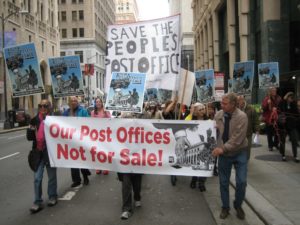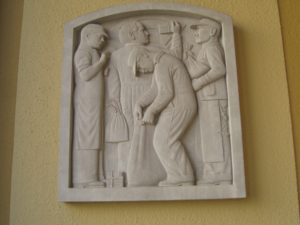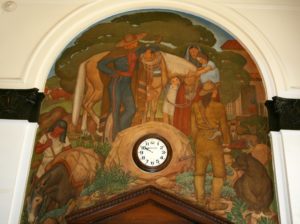
Marjory Stoneman Douglas
Writer and activist Marjory Stoneman Douglas.
“It is as if there were places and times in which human activity becomes a whirlpool which gathers force not only from one man’s courage and ambitions and high hopes but from the very tides of disaster and human foolishness which otherwise disperse them.”
“A whirlpool which gathers force.” Interestingly, these words were written by Marjory Stoneman Douglas–the namesake of the school in Parkland, Florida, where in February, yet another shooting massacre took place.

American Guide to Miami
Published under the auspices of the Federal Writers’ Project, the American Guide Series contains detailed histories of each of the then 48 states and major cities and towns.
Douglas, who died in 1998 at the age of 108, might have been describing the student activists who have taken up the fight against the NRA and the politicians who support archaic gun laws. But Douglas’s words appeared in the foreword she wrote to the 1941 edition of A Guide to Miami and Dade County, one of the books in the Works Progress Administration’s American Guide series.
The WPA guides, published by the New Deal’s Federal Writers Project between 1935 and 1943, were intended to create jobs and spur tourism during the Great Depression. The FWP hired thousands of unemployed writers, librarians, clerks, researchers, editors, and historians around the country—including Douglas, a journalist, and activist throughout her long life.
Douglas is best known for her tireless crusade to save the Florida Everglades. But throughout her life, she also supported such causes as women’s rights, civil liberties, and racial justice.

The Everglades, River of Grass
Douglas’s book, published in 1947, the same year that the Everglades became a national park, remains a call to action.
She was a suffragette at Wellesley College, and actively fought for women’s right to vote until the 19th Amendment was enacted in 1920. Arriving in South Florida in 1915 when barely 5,000 people lived in Miami, she began her career as a society columnist for her father’s newspaper, which later became the Miami Herald.
Like Henry Alsberg, director of the FWP and editor of the WPA American Guide series, Douglas spent time in Europe after World War I aiding war refugees. Upon returning to Florida, she turned to covering social and environmental themes, including the importance of preserving the Everglades and its ecosystem.
Douglas, who stood 5 foot 2 and weighed barely 100 pounds, famously did battle with the Army Corps of Engineers, the State of Florida, and powerful business interests over draining the Everglades for agriculture and real estate development. Her 1947 book, The Everglades: River of Grass, still considered groundbreaking, “galvanized public interest in protecting the Everglades,” according to the Florida Department of State. In 1969, at age 79, Douglas founded Friends of the Everglades.
When she was 103, President Bill Clinton, calling her the “Grandmother of the Glades” presented Douglas with the Medal of Freedom. Still-wild portions of the Everglades are named in her honor. At a ceremony on Earth Day, 2015, Douglas’s home in Dade County, Florida, was listed on the National Register of Historic Places.

Student March
Students in Parkland, Florida mounted a campaign to end gun violence after 17 died at the Marjory Stoneman Douglas High School.
Photo Credit: Wikimedia Commons
But more than these “official” honors Douglas would surely be proud of the students who hail from Marjory Stoneman Douglas High School for carrying on her efforts to build a better world.
“Be a nuisance where it counts,” Douglas once said. “Do your part to inform and stimulate the public to join your action. Be depressed, discouraged, and disappointed at failure and the disheartening effects of ignorance, greed, corruption, and bad politics—but never give up.”
John Rothchild, who helped write Douglas’s autobiography, said that her death was the only thing that could “shut her up.”
He added, “And the silence is terrible.”
Susan Rubenstein DeMasi is the author of the 2016 biography, Henry Alsberg: The Driving Force of the New Deal Federal Writers’ Project. She is a visiting scholar in this summer’s National Endowment for the Humanities program, “The New Deal Era’s Federal Writers’ Project,” as well as a contributor to an upcoming book on the literary legacy of the FWP, edited by Sara Rutkowski, for the University of Massachusetts Press.
[email protected]















